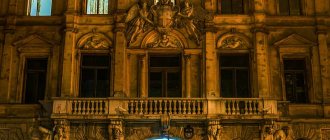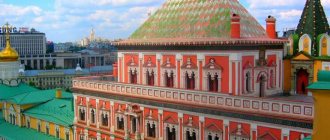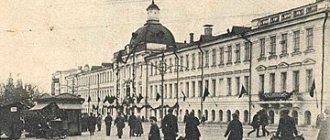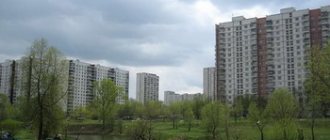There are many strange, mysterious places in Moscow. But one of them is especially attractive both for those interested in paranormal phenomena and for ordinary tourists. This is Golosov Ravine, located on the territory of the Kolomenskoye Museum-Reserve. It starts at the banks of the Moscow River and stretches all the way to Andropov Avenue. Velesov Ravine, as this natural formation is also called, is no different in appearance from many other similar relief bends. But it still has characteristic features. Firstly, these are sandstones located at the bottom. And secondly, mystical incidents, which, according to legend, often happened in these places. This place became especially popular after the publication of the story “Green Fog (author Konstantin Grigoriev). In this work, the characters find themselves in the future through Golosov Ravine. It is unknown whether the numerous visitors to the park in Kolomenskoye want to do the same, but there are quite a lot of people here, especially on weekends.
Place of power
Kolomenskoye is called a place of power ; Tsar Ivan the Terrible often visited here. Although there is a version according to which the ruler became so cruel precisely because he spent a lot of time in this residence. After all, events took place in Golosovo ravine that still cannot be explained.
In the first millennium BC, the Finno-Ugric tribe Merya settled on a hill near a mysterious area. These residents were called Dyakovtsy; they performed ritual prayers and magical rites in the ravine. Strange things happened here. And later Velesov ravine in Kolomenskoye began to be called Dyakov or Dyakovsky.
You can climb 66 steps to the bottom of the slope, and another 18 lead to the Moscow River. The old residents of this area say: “Moscow is the navel of the earth, the navel of Moscow is in the Velesov ravine.” At the bottom of the ravine, geologists found a fault dating back to the Jurassic period. Esotericists call the crack the gateway to hell. And archaeologists are puzzling over how and where the entire Dyakovo tribe disappeared along with the village three hundred years before the founding of the capital of Russia.
It’s easy to get to Golosov ravine in Kolomenskoye. It seems to cross the planet’s magnetic field and is on a straight line running from west to east. The slope divides Kolomna into two halves, and a small stream with cold water flows along its bottom. All year round its temperature does not rise above four degrees. And in winter it never freezes, although scientists cannot explain this phenomenon.
Story
The name Velesov ravine is associated with the name of the Slavic god Veles (Volos). This version was promoted by A. Chigrin, who worked as a guide at the Kolomenskoye Museum. As a student at the Faculty of History, he defended his coursework and diploma work, in which he argued that the stones of Golosov Ravine were a sanctuary from pagan times. If we consider that the remains of settlements dating back to the 1st century BC were found in the surrounding area, then such a hypothesis has a right to exist. Moreover, the geology of Golosov ravine is also specific. Directly below this place there is an underground volcanic fault. times , such places were considered very strong and were used for the construction of various religious buildings.
Time Portal
Velesy slope has long had a bad reputation. Local residents say that there is a time portal here. Every local old-timer has legends and photographs of the Golosov ravine in Kolomenskoye. There are rumors that sometimes a green fog descends here. Once you enter it, the ravine will transport a person 30-50 years into the future.
Several similar cases have been recorded:
- in 1621;
- 1810;
- 1926.
The first case was associated with a Tatar detachment. The warriors of Devlet Giray approached the royal palace, where they were detained by arrows. The Tatars argued that they entered the greenish fog in 1571, and emerged from it only half a century later. Outdated weapons and inquiry confirmed the veracity of their words.
The situation repeated itself in the nineteenth century. In 1832, the newspaper Moskovskie Vedomosti described a similar case. Two peasants - Kuzmin Arkhip and Bochkarev Ivan - went missing in 1810. But unexpectedly they found themselves in their village 21 years later. In the evening, the friends were walking home from a neighboring village and entered the green fog at the bottom of the ravine. Suddenly a whitish corridor appeared in front of them, where there were people covered with fur. They showed the peasants the way back. The villagers did not believe Arkhip and Ivan. The police decided to conduct an investigative experiment. Of the several employees who descended into the fog of the ravine, one disappeared.
Similar disappearances still occur today. But local residents prefer not to talk about the ravine in Kolomenskoye, in which people disappear. In 1926, here a patrolman met a savage covered in fur. The policeman was frightened by the huge stranger - the creature was about 2.5 m tall - and shot him with his service pistol. The silhouette simply disappeared into the fog.
A few years later, two schoolchildren got lost on the slope. They entered the greenish haze and stayed there for about half an hour, in their opinion. In fact, the boys were not at home for 2 days; their parents and the police were already looking for them.
Mysteries and mysticism of Kolomenskoye
My dear peek-a-boo and everyone who came to see the light!
I love all sorts of mystical stories. And today I’ll tell you about the secrets of Kolomenskoye
I won’t talk about the fact that this is an ancient royal estate, I’ll tell you about what not everyone knows.
I will only say that Kolomenskoye is often “confused” with Kolomna, and so - they are connected - the village of Kolomenskoye, located on the road from Moscow to Kolomna, was founded, according to legend, by residents of the city of Kolomna who fled from Batu. The first written mention occurs in 1336.
There are three very famous churches in Kolomenskoye: Temple of the Icon of the Kazan Mother of God (with blue domes - a symbol of the Kingdom of Heaven, five domes - in the center - a symbol of the Lord God, along the perimeter - four evangelists).
The Church of the Ascension of the Lord is the first tented stone church in Rus', which was erected in honor of the birth of Ivan the Terrible (on the night of his birth there was a terrible thunderstorm, when “lightning flashed throughout the Russian land and the earth opened up to the Underworld”). Initially, the temple was built exclusively for members of the royal family, and the royal treasury was kept in the basement. The church itself is surrounded by a gallery - a walkway - on it stands a white stone throne, on which Ivan Vasilyevich himself loved to sit.
And across the ravine, on a hill, stands the Church of the Beheading of John the Baptist, which is considered the prototype of St. Basil's Cathedral on Red Square. It is believed that Ivan the Terrible laid it down as a prayer for an heir. However, there is another version - that Tsar Ivan built it in memory of his royal wedding.
Since ancient times, Kolomenskoye has been considered a place of power and it was here that there were pagan temples. For both the country and a specific person. It is here, according to some legends, that Liberia is hidden - the famous library of Ivan the Terrible, which he inherited from his grandmother Sophia Paleologue and was considerably supplemented by him. According to some reports, it also contained a collection of occult books, including Agrippa of Nettisheim. They said that Tsar Ivan, during his lifetime, divided the library - his Liberia - into black and light parts. The black one was walled up in a dungeon, and the light one was kept in “open access.” A curse has been placed on Liberia: whoever touches it ahead of time - and this is 800 years - will die a terrible death! All of Kolomenskoye, according to quite scientific facts, is cut up with passages and dungeons.
Tsar Alexei Mikhailovich, who ruled after the Time of Troubles and remembered the reprisals against boyars and rulers, was concerned about his own safety, and therefore built an underground passage from the Temple of the Kazan Mother of God. Initially it was believed that the passage leads to the Church of the Ascension, but there are suggestions that there is a second passage - UNDER THE RIVER - which opens onto the ground in the Nikolo-Perervinskaya monastery, in a completely different area of Moscow - in Pechatniki. Before the war, they were held in the "Kazan" church archaeological excavations - and a secret door and passage to the tunnel were even discovered. Archaeologist and mystic Ignatius Yakovlevich Stelletsky, who worked in Kolomenskoye, wrote in his diary in 1930: “Two hatches and two sloping corridors lead from the church near the altar to the basement.” He managed to carry out some work, but further research was suspended at the insistence of the directorate of the museum-reserve, since there was a danger of the church floor collapsing. In 1938, Stelletsky began excavations in the vicinity of the Church of the Baptist, drawing attention to the hilly area between a steep cliff and the floodplain of the Moscow River - it looked too unnatural. After research, it turned out that this is an artificial formation consisting of a dump of sandy rock, while the upper layers of the soil contain loam. During the work, the archaeologist came across massive limestone masonry at a depth of 7 meters. He was sure that under the temple there was “some colossal underground storage facility.” However, the war soon began, Stelletsky’s archives disappeared, and he himself died.
On the eve of the Olympics-80, at the altar in the temple in Dyakovo, loose sand was discovered under one of the slabs, and under it were steps made of white stone leading to an underground passage, also made of white stone. However, at that time the work could not be continued due to lack of funds, so the hole was filled with sand and topped with a half-meter layer of concrete... However, historians say that in the Church of the Beheading of John the Baptist a stove-air heating system was equipped, which is quite it is likely that it was not an underground passage that was discovered, but one of the channels of this system. However, there are dungeons under the church - because in 1929, under the altar, the tomb of the priest of the Dyakovo Church was discovered. Dowsing experts claim that there is also a secret passage from Kolomenskoye to the Kremlin. There is also a version that one of the underground passages leads to the legendary Golosov ravine - Velesov, or Volosov, ravine.
Etymologically, the name Voices is associated with Veles, or Volos, the name of the pagan god, ruler of the underworld, secret knowledge and patron of domestic animals and wealth.
According to legends and eyewitness accounts, in the ravine there is a Time Portal through which you can “pass” through another era. Moreover, the opening of the Portal is certainly accompanied by the appearance of green fog - and this usually happens in the evening.
This is described in 19th century newspapers and even in police reports.
So, in July 1832, an article appeared in the Moskovskie Vedomosti newspaper about two peasants, Arkhip Kuzmin and Ivan Bochkarev, who, returning home from a neighboring village at night, decided to shorten the road and go through Golosov Ravine. A thick green fog swirled at the bottom of the valley, in which some kind of “corridor flooded with pale light” suddenly appeared. The men entered it and met people covered with fur, who tried to show them the way back with signs. A few minutes later the peasants emerged from the fog and continued on their way. When they arrived in their native village, it turned out that two decades had already passed. Their wives and children, 20 years older, had difficulty recognizing them. The police intervened in the matter. At the insistence of investigators, an experiment was conducted in the ravine, during which one of the time travelers disappeared into the fog again and never returned.
Documents of the Police Department for the period 1825-1917. indicate that in the Moscow province and specifically in the Kolomenskaya volost, mysterious disappearances of people repeatedly occurred among the residents of the villages of Kolomenskoye, Sadovniki, Dyakovo and Novinki. In the Sophia Vremennik there is a story about how in 1621 a small detachment of Tatar horsemen unexpectedly appeared at the gates of the royal palace in Kolomenskoye. They were surrounded by archers guarding the gates and immediately taken prisoner. The horsemen said that they were warriors of Khan Devlet-Girey, whose troops tried to capture Moscow in 1571, but were defeated. Hoping to escape pursuit, the cavalry detachment descended into Golosov Ravine, shrouded in thick fog. The Tatars spent there, as it seemed to them, for several minutes, but emerged only 50 years later. One of the prisoners said that the fog was unusual, glowing with a greenish color, but in fear of being chased, no one paid attention to this. Tsar Mikhail Fedorovich ordered an inquiry, which showed that the Tatars were most likely telling the truth. Even their weapons and equipment no longer corresponded to the weapons of that time, but were more like outdated models of the mid-16th century.
But this ravine is not only associated with paganism.
Legends say that the battle between St. George the Victorious and the Serpent took place here.
“But the saint, seeing the serpent, made the sign of the cross and with the words “In the Name of the Father and the Son and the Holy Spirit” rushed at him. The Great Martyr George pierced the serpent's throat with a spear and trampled it with his horse. Then the saint killed the serpent with a sword, and the inhabitants burned it outside the city. Twenty-five thousand people, not counting women and children, were baptized that day.” (Life of St. George the Victorious)
In the battle with the Serpent, George’s horse fell - he was cut by the monster’s tail. The springs along the stream in the ravine are traces of his hooves, and his remains turned into two huge boulders, the “Goose (or Horse) Stone” and the “Maiden Stone.” They are called Desire Stones - male and female, respectively.
According to some sources, the Devy Stone is also called Perunov, its age is 4-5 thousand years.
Each stone weighs about five tons. The bulk of these boulders are in the ground, and small peaks come to the surface. These blocks of Lower Cretaceous quartz sandstone were brought to Moscow from Scandinavia by glaciers during the Ice Age.
The deepest spring is called Georgievsky. There is also the spring of St. Nicholas the Saint, the spring of the Twelve Apostles and a group of Kadochka springs.
“Golosov Ravine is located strictly from west to east, it seems to cut through the natural magnetic field of the Earth. The ravine conditionally divides Kolomenskoye into two almost equal parts. A small stream flows along the bottom of the ravine, formed by springs, of which there are a great many here. The water in the stream is very cold. Its temperature is the same all year round - plus 4 degrees, which gives it the properties of the greatest density and life-giving power. In winter, the stream does not freeze even in severe frosts, for which no one has yet given an explanation.
According to research by geologists, Moscow stands on the Russian Platform, a solid geological formation. However, it has its own faults, and one of the largest runs under the Golosov Ravine. Powerful radiation emerges through the rift, and the west-to-east orientation cuts through the Earth's natural magnetic field.
Back in 1995-1996, scientists from the Institute of General Physics measured electromagnetic fields near the stones. The results were stunning. The excess of the norm of electromagnetic radiation in the ravine is more than 12 times, near boulders – more than 27 times. It has been noticed that sometimes mobile phones suddenly run out of charge here, and the compass needle points from different places not to the north, but to the epicenter of the enchanted ravine.
Author's text and photographs - Natalia Budur (c)
Magic stones
The mysticism of the ravine is associated not only with a foggy time portal. There are two huge boulders on the slope:
- Goose-stone;
- Devy.
The first is considered a male boulder. It lies at the bottom of the ravine, and its surface is covered with pimples, which makes it look like goose skin. The guy needs to sit on it, then the stone will give him the courage of a warrior, luck in battle and masculine strength. If you apply soil taken from under a boulder to a sore spot, the person will soon recover. On the south side there is a small depression in the Goose Stone called the “heart of a horse.” Previously, it served as a sacrificial temple for pagans. And under it there is another recess where holy water flows. Visitors to the ravine decorate the boulder with ribbons and flowers.
Maiden's stone is bubbly, it resembles a woman's breast or the heads of babies. It is endowed with special powers that heal infertility and other diseases of the genitourinary system. Each of its bulges, when applied correctly, has a beneficial effect on the girl’s body. Ritual scheme for quickly conceiving a child:
- draw water from a spring;
- sit on the maiden stone;
- make a wish for a child;
- drink liquid;
- tie a red or blue ribbon to any part of the boulder;
- believe in his healing power.
According to legend, a battle took place in Golosovo ravine between St. George the Victorious and the serpent. When the enemy hit the saint's horse, the animal split into two parts - the head and the body. The first piece turned into a female stone, and the second into a male stone. On the surface of the maiden boulder you can see the outlines of the Madonna and Child in her arms. At the top of the boulder there is a small depression in which water accumulates. The earth from under the stone is also used to treat diseases by applying it to the body.
And in the tracks of horse hooves, the purest springs gushed out. They flow in the secluded corners of the ravine. Washing with cold water can restore vision, and internal organs will become healthy if you drink liquid. There is a legend about the healing of infertility in one of the wives of Ivan the Terrible. Since then, other girls have prayed at the women's stone and the spring located next to it.
Boulders are able to fulfill cherished desires that have nothing to do with the birth of a child. To do this, you need to put your hand on the surface of the stone and think about your dream. Then tie a ribbon around the nearest tree, leaving your mark in the magical place. And soon the wish will become a reality.
Restoration work
The unique buildings of the 16th–17th centuries preserved on the territory of Kolomenskoye, especially the Church of the Ascension of the Lord, attracted the attention of the scientific and artistic community already at the end of the 19th century. In 1913–1916, the first restoration work began on the Kolomensky monuments, and in the 20s, through the efforts of the outstanding architect-restorer Pyotr Baranovsky, a museum was organized here. In 1923, Baranovsky achieved the establishment of a folk art museum in Kolomenskoye and became its first director. In the late 20s - early 30s, he found and brought to Kolomenskoye monuments of wooden architecture: the house of Peter I from Arkhangelsk, the Mokhovaya Tower from the Sumy fort, an outbuilding from Preobrazhenskoye, etc.
Under him, the condition of architectural monuments was recorded, their historical appearance was returned, and later layers were removed during restoration. As a result of such restoration, for example, the bell tower of St. George's Church was separated from the refectory - the connecting extension was demolished by Baranovsky. In Kolomenskoye, Baranovsky founded his own school of restoration.
Connection with space
Residents of the settlement believe that healing stones emit special cosmic energy. In 1995, specialists from the Institute of General Physics decided to study this phenomenon. It was discovered that the ravine itself exceeds the norm for the intensity of electromagnetic fields by 12 times, and the stones by 27 times.
After this, the researchers became convinced that this ancient settlement was connected with space. Visitors say that equipment often breaks down here. Strange spots appear in photographs taken in this area. The compass needle points to the center of the ravine, not to the north.
For several centuries, visitors periodically encountered tall, hairy people. These cases were recorded both in the royal chronicles and in Soviet newspapers. Usually the “goblin” hid under the trees, and when tourists appeared they simply melted into thin air.
Royal Library
Ivan the Terrible's grandmother brought a huge library, Liberia, to his estate. But after the death of the king, it was discovered that the collection had disappeared. In those years, there was a legend about the curse of anyone who touched ancient books. The royal grandmother was a sorceress ; she personally decided to cast spells on everyone who encroached on the library. The collection also contained an old textbook on black magic.
Ivan the Terrible divided all books into open and prohibited. He allowed the first part to be read by his entourage, and ordered the second part to be walled up in the basement of the estate. Researchers have established for sure that the lost library is located in the Kolomna residence.
A few years before the war, a church watchman found a small door in the wall of the temple. He picked up the key and went down the stairs into the dungeon. But when he came across another door and saw an ancient skeleton, he rushed back to the church. It was necessary to lay a kind of cemetery inside the building with bricks.
In 1938, archaeologist Stelletsky began excavations in the Church of the Beheading of John the Baptist. He discovered limestone masonry at a depth of seven meters. The scientist suggested that underneath it there is a dungeon with a lost library. But when the war began, the archaeologist died and the excavations stopped.
Further attempts to find the royal collection were also unsuccessful. Everyone who tried to dig the dungeon reported strange phenomena. It was said that the restless soul of Ivan the Terrible walks around the temple and protects the library. Seekers will face the wrath of the king, his shamanic rituals and curses. According to legend, the collection of books will be hidden for 800 years, then it will be discovered.
Terem Palace
Golosov Ravine is famous not only for its mystical stories, but also for the beauty of its landscapes. A palace-city was built on the banks of the Moscow River by order of Tsar Alexei . The work lasted almost 20 years , the results are impressive.
The walls of the building are decorated with gold, the ceiling is covered with paintings, and the floors are covered with expensive Turkish carpets. Mechanical figures of lions decorated the throne room with the throne of the ruler. Since such structures did not yet exist, foreign guests considered the movable sculptures magical.
But when St. Petersburg became the capital of the state, the palace was abandoned. Later, Catherine the Second ordered it to be dismantled down to bricks and clay. But first, the architects drew up drawings of the building and took all measurements. With the help of these documents and maps, the palace was restored to its original form. It is easy to get to the majestic structure; it is located near the ravine.
There is a lot to see in this area. Most of all, visitors are interested in the male and female stones, healing springs and a temporary portal in the ravine. You can also admire the restored palace and beautiful nature.
Museum-reserve today
The first exhibitions of the museum were located in the premises of the Sytny Dvor and the Chambers of Orders. The main museum exhibitions are still located here today.
In 2004, in the Palace Gate complex, of which the Order Chambers are part, the exhibition “Milestones in the History of Kolomenskoye” was opened, dedicated to the history of the village near Moscow and its environs from ancient times to the 30s of the 20th century. It displays archaeological antiquities, icons, portraits, books, bells, tiles, weapons, and household items from the 15th to 19th centuries. The reconstruction of the interior of the Order Chamber from the time of Tsar Alexei Mikhailovich is also interesting. The first such reconstruction of a 17th-century office interior was carried out by Baranovsky. In continuation of the tradition he began, the modern reconstruction, prepared by the staff of the museum-reserve, is based on the latest research into the culture and life of Kolomna and Moscow in the 17th century.
In the restored glacier cellars, for the first time, part of the unique collection of white-stone architectural details of the 17th–18th centuries is exhibited, which was started by Baranovsky, saving individual historical monuments during the destruction of White-Stone Moscow. The name of the museum’s founder is also associated with a collection of icons from the 16th–19th centuries, which depict Russian cities, monasteries and their patron saints.
In 2008–2010, on the territory of the former village of Dyakovskoye, a model of the palace was built with a partial recreation of the interiors, but without reference to the historical location and orientation to the cardinal points. The model was built according to drawings drawn up at the behest of Catherine II. During the construction, modern technologies were used - all structures are monolithic, reinforced concrete, then covered with logs with partial reconstruction of the interiors.
In recent years, the Church of the Ascension of the Lord, a monument included in the UNESCO World Heritage List, as well as the Front Gate complex, the Palace Pavilion of 1825, the bell tower and the Church of St. George the Victorious have been restored in Kolomenskoye.





